HI6008: Big Data Impact on Business Innovation & Performance 2018
VerifiedAdded on 2023/06/11
|14
|3688
|218
Report
AI Summary
This research proposal investigates the impact of big data on business innovation and performance. It outlines the project's objectives, scope, and provides a literature review summarizing previous research on the topic. The proposal includes primary and secondary research questions focused on big data's role in managing information, its application across various sectors, and the challenges organizations face in its implementation. The research design employs an explanatory approach, utilizing a mixed-methods strategy with both qualitative and quantitative data collected through questionnaire surveys. The proposal details the key steps, research strategy, approach, instrument, data collection, analysis, sampling, and considerations for reliability and validity. It also acknowledges research limitations and presents a time schedule for the project. The research aims to provide insights into how big data influences innovation capabilities and overall business performance.
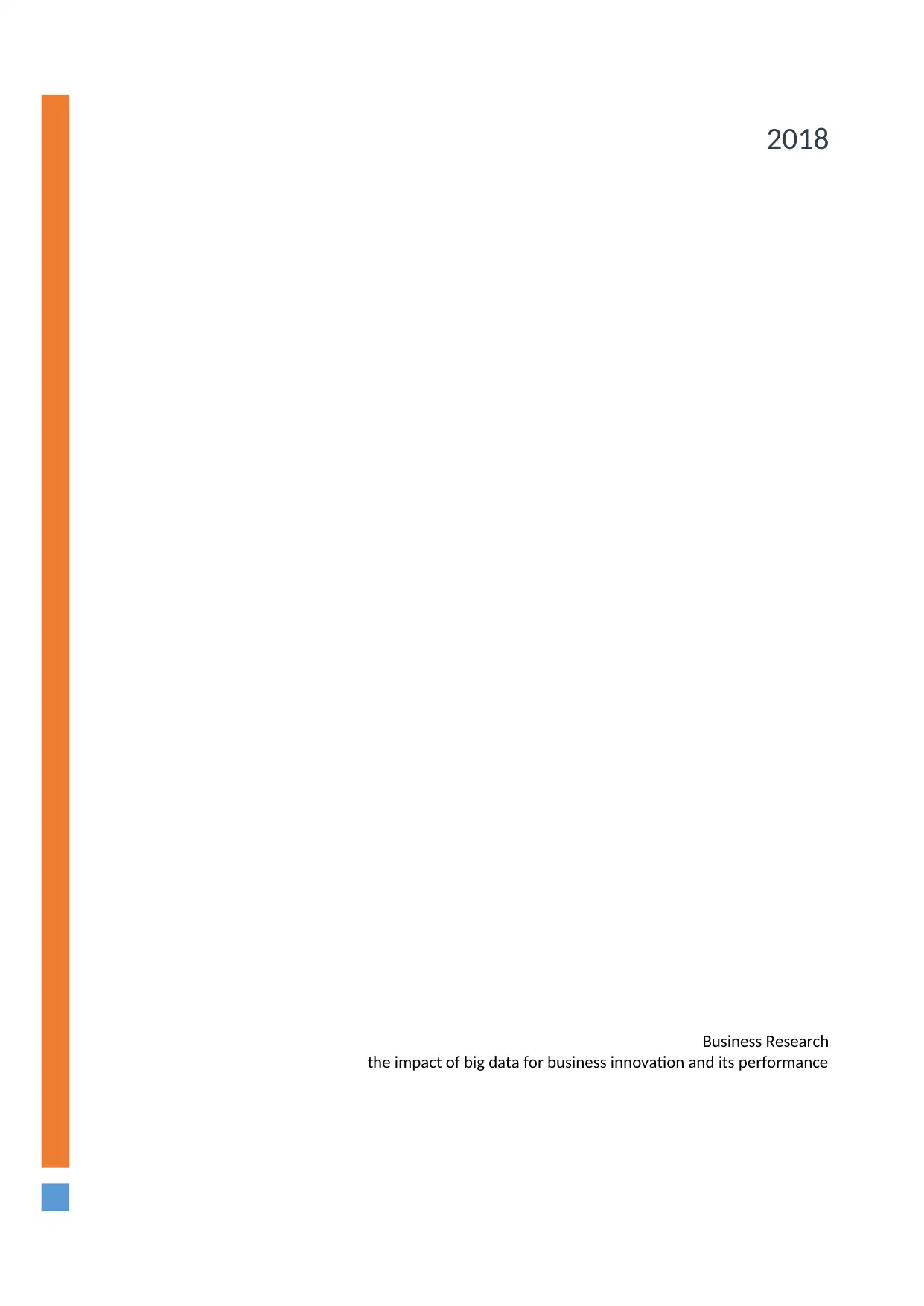
Business Research
the impact of big data for business innovation and its performance
2018
the impact of big data for business innovation and its performance
2018
Paraphrase This Document
Need a fresh take? Get an instant paraphrase of this document with our AI Paraphraser
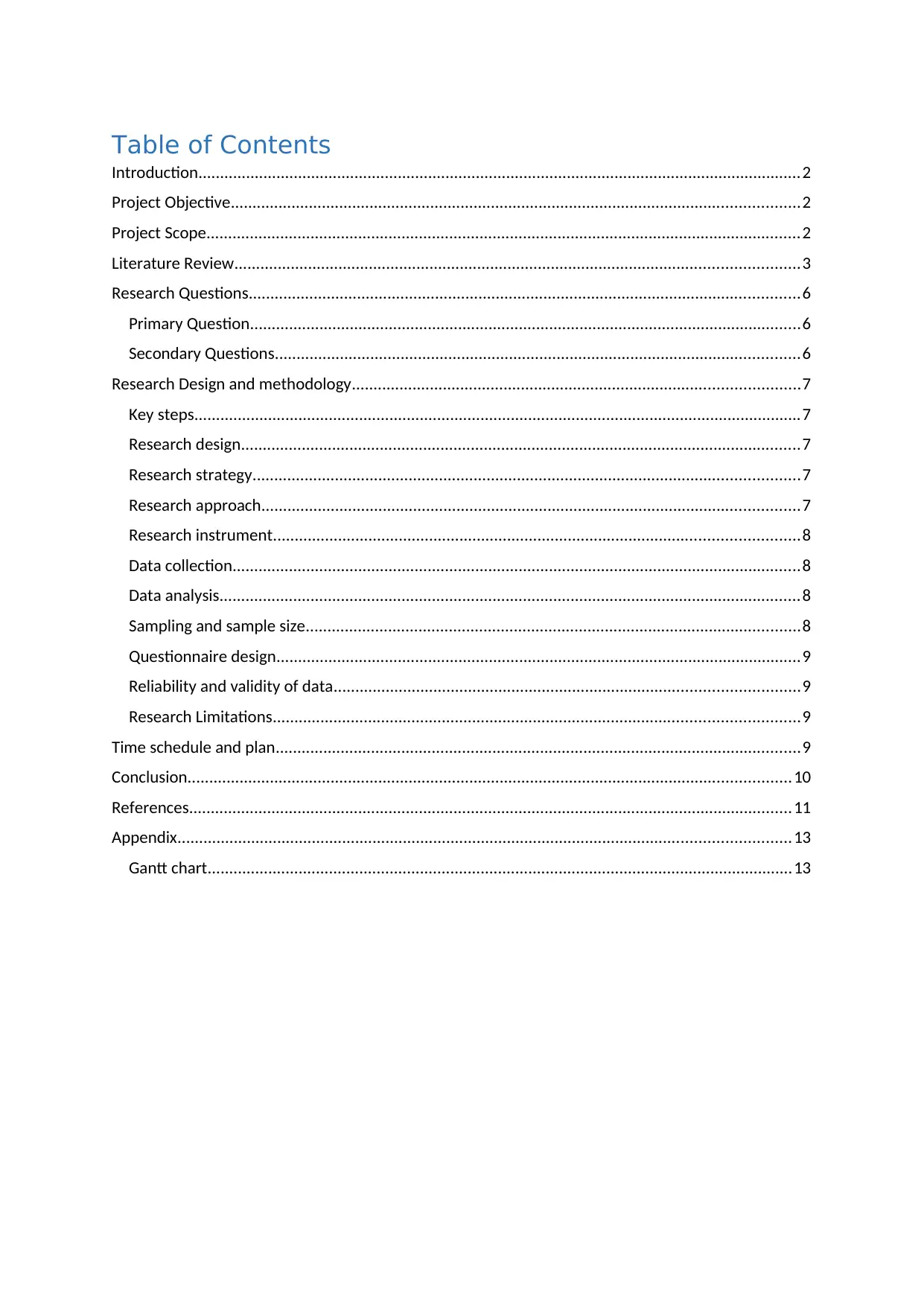
Table of Contents
Introduction...........................................................................................................................................2
Project Objective...................................................................................................................................2
Project Scope.........................................................................................................................................2
Literature Review..................................................................................................................................3
Research Questions...............................................................................................................................6
Primary Question...............................................................................................................................6
Secondary Questions.........................................................................................................................6
Research Design and methodology.......................................................................................................7
Key steps............................................................................................................................................7
Research design.................................................................................................................................7
Research strategy..............................................................................................................................7
Research approach............................................................................................................................7
Research instrument.........................................................................................................................8
Data collection...................................................................................................................................8
Data analysis......................................................................................................................................8
Sampling and sample size..................................................................................................................8
Questionnaire design.........................................................................................................................9
Reliability and validity of data...........................................................................................................9
Research Limitations.........................................................................................................................9
Time schedule and plan.........................................................................................................................9
Conclusion...........................................................................................................................................10
References...........................................................................................................................................11
Appendix.............................................................................................................................................13
Gantt chart.......................................................................................................................................13
Introduction...........................................................................................................................................2
Project Objective...................................................................................................................................2
Project Scope.........................................................................................................................................2
Literature Review..................................................................................................................................3
Research Questions...............................................................................................................................6
Primary Question...............................................................................................................................6
Secondary Questions.........................................................................................................................6
Research Design and methodology.......................................................................................................7
Key steps............................................................................................................................................7
Research design.................................................................................................................................7
Research strategy..............................................................................................................................7
Research approach............................................................................................................................7
Research instrument.........................................................................................................................8
Data collection...................................................................................................................................8
Data analysis......................................................................................................................................8
Sampling and sample size..................................................................................................................8
Questionnaire design.........................................................................................................................9
Reliability and validity of data...........................................................................................................9
Research Limitations.........................................................................................................................9
Time schedule and plan.........................................................................................................................9
Conclusion...........................................................................................................................................10
References...........................................................................................................................................11
Appendix.............................................................................................................................................13
Gantt chart.......................................................................................................................................13
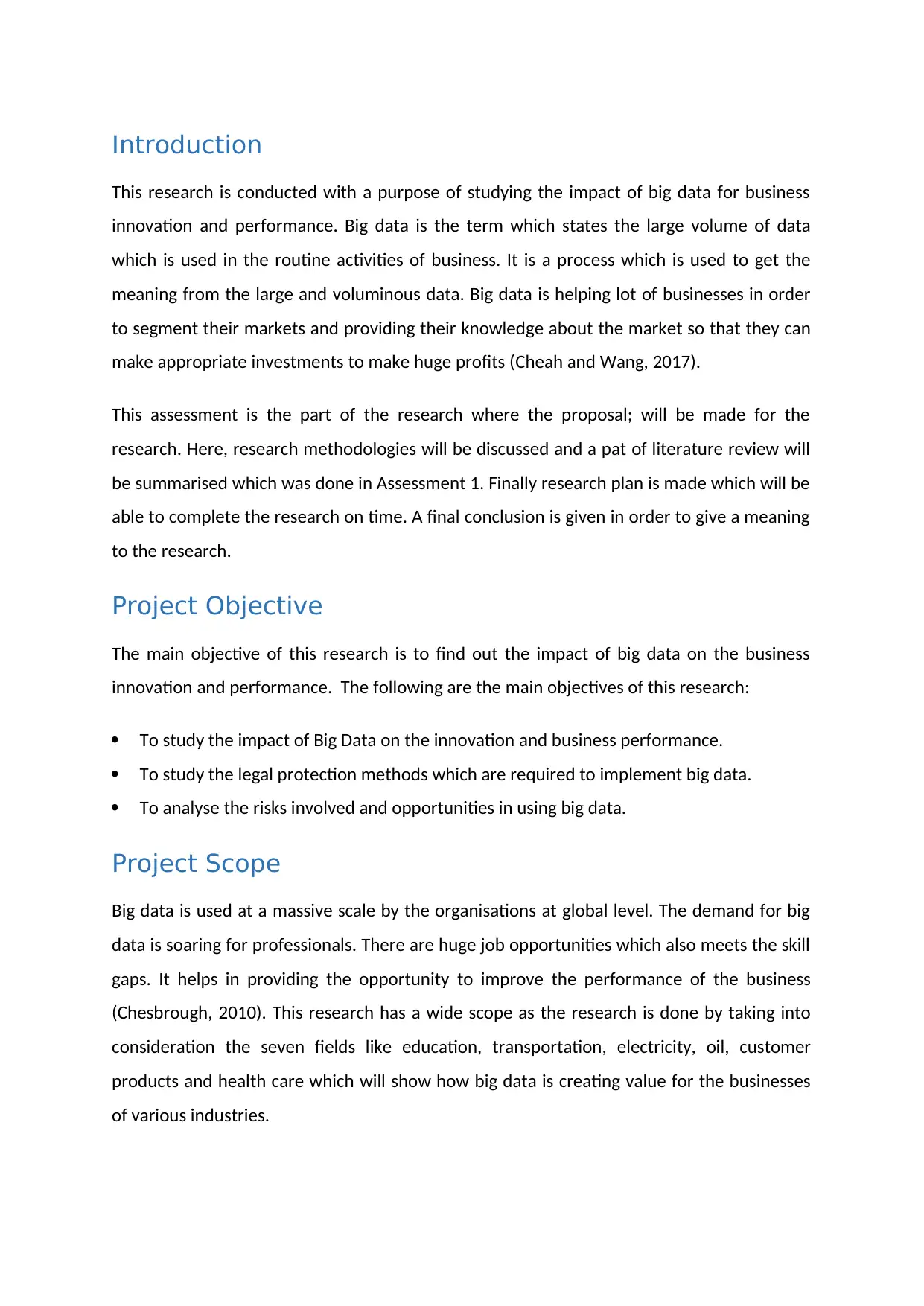
Introduction
This research is conducted with a purpose of studying the impact of big data for business
innovation and performance. Big data is the term which states the large volume of data
which is used in the routine activities of business. It is a process which is used to get the
meaning from the large and voluminous data. Big data is helping lot of businesses in order
to segment their markets and providing their knowledge about the market so that they can
make appropriate investments to make huge profits (Cheah and Wang, 2017).
This assessment is the part of the research where the proposal; will be made for the
research. Here, research methodologies will be discussed and a pat of literature review will
be summarised which was done in Assessment 1. Finally research plan is made which will be
able to complete the research on time. A final conclusion is given in order to give a meaning
to the research.
Project Objective
The main objective of this research is to find out the impact of big data on the business
innovation and performance. The following are the main objectives of this research:
To study the impact of Big Data on the innovation and business performance.
To study the legal protection methods which are required to implement big data.
To analyse the risks involved and opportunities in using big data.
Project Scope
Big data is used at a massive scale by the organisations at global level. The demand for big
data is soaring for professionals. There are huge job opportunities which also meets the skill
gaps. It helps in providing the opportunity to improve the performance of the business
(Chesbrough, 2010). This research has a wide scope as the research is done by taking into
consideration the seven fields like education, transportation, electricity, oil, customer
products and health care which will show how big data is creating value for the businesses
of various industries.
This research is conducted with a purpose of studying the impact of big data for business
innovation and performance. Big data is the term which states the large volume of data
which is used in the routine activities of business. It is a process which is used to get the
meaning from the large and voluminous data. Big data is helping lot of businesses in order
to segment their markets and providing their knowledge about the market so that they can
make appropriate investments to make huge profits (Cheah and Wang, 2017).
This assessment is the part of the research where the proposal; will be made for the
research. Here, research methodologies will be discussed and a pat of literature review will
be summarised which was done in Assessment 1. Finally research plan is made which will be
able to complete the research on time. A final conclusion is given in order to give a meaning
to the research.
Project Objective
The main objective of this research is to find out the impact of big data on the business
innovation and performance. The following are the main objectives of this research:
To study the impact of Big Data on the innovation and business performance.
To study the legal protection methods which are required to implement big data.
To analyse the risks involved and opportunities in using big data.
Project Scope
Big data is used at a massive scale by the organisations at global level. The demand for big
data is soaring for professionals. There are huge job opportunities which also meets the skill
gaps. It helps in providing the opportunity to improve the performance of the business
(Chesbrough, 2010). This research has a wide scope as the research is done by taking into
consideration the seven fields like education, transportation, electricity, oil, customer
products and health care which will show how big data is creating value for the businesses
of various industries.
⊘ This is a preview!⊘
Do you want full access?
Subscribe today to unlock all pages.

Trusted by 1+ million students worldwide
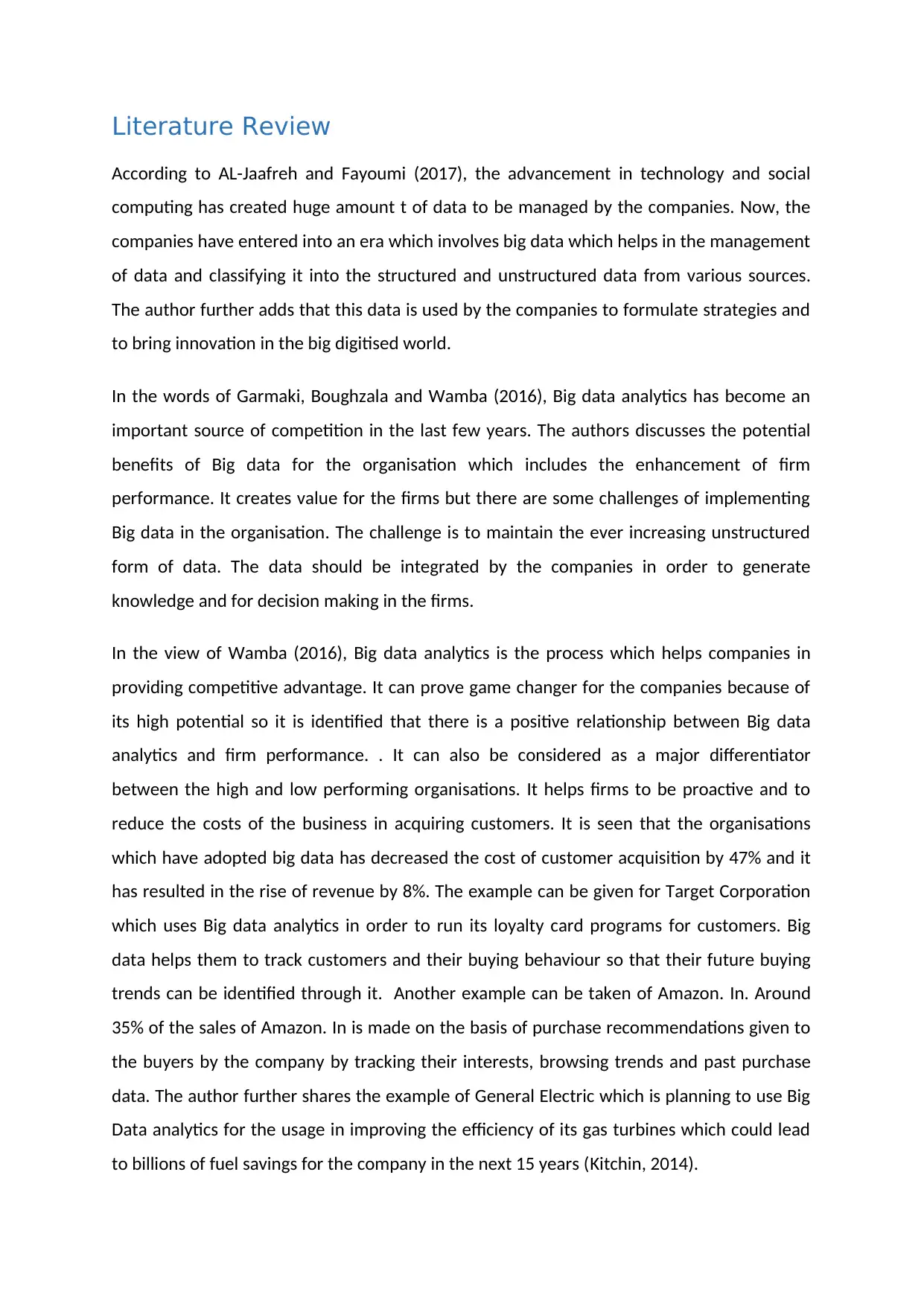
Literature Review
According to AL-Jaafreh and Fayoumi (2017), the advancement in technology and social
computing has created huge amount t of data to be managed by the companies. Now, the
companies have entered into an era which involves big data which helps in the management
of data and classifying it into the structured and unstructured data from various sources.
The author further adds that this data is used by the companies to formulate strategies and
to bring innovation in the big digitised world.
In the words of Garmaki, Boughzala and Wamba (2016), Big data analytics has become an
important source of competition in the last few years. The authors discusses the potential
benefits of Big data for the organisation which includes the enhancement of firm
performance. It creates value for the firms but there are some challenges of implementing
Big data in the organisation. The challenge is to maintain the ever increasing unstructured
form of data. The data should be integrated by the companies in order to generate
knowledge and for decision making in the firms.
In the view of Wamba (2016), Big data analytics is the process which helps companies in
providing competitive advantage. It can prove game changer for the companies because of
its high potential so it is identified that there is a positive relationship between Big data
analytics and firm performance. . It can also be considered as a major differentiator
between the high and low performing organisations. It helps firms to be proactive and to
reduce the costs of the business in acquiring customers. It is seen that the organisations
which have adopted big data has decreased the cost of customer acquisition by 47% and it
has resulted in the rise of revenue by 8%. The example can be given for Target Corporation
which uses Big data analytics in order to run its loyalty card programs for customers. Big
data helps them to track customers and their buying behaviour so that their future buying
trends can be identified through it. Another example can be taken of Amazon. In. Around
35% of the sales of Amazon. In is made on the basis of purchase recommendations given to
the buyers by the company by tracking their interests, browsing trends and past purchase
data. The author further shares the example of General Electric which is planning to use Big
Data analytics for the usage in improving the efficiency of its gas turbines which could lead
to billions of fuel savings for the company in the next 15 years (Kitchin, 2014).
According to AL-Jaafreh and Fayoumi (2017), the advancement in technology and social
computing has created huge amount t of data to be managed by the companies. Now, the
companies have entered into an era which involves big data which helps in the management
of data and classifying it into the structured and unstructured data from various sources.
The author further adds that this data is used by the companies to formulate strategies and
to bring innovation in the big digitised world.
In the words of Garmaki, Boughzala and Wamba (2016), Big data analytics has become an
important source of competition in the last few years. The authors discusses the potential
benefits of Big data for the organisation which includes the enhancement of firm
performance. It creates value for the firms but there are some challenges of implementing
Big data in the organisation. The challenge is to maintain the ever increasing unstructured
form of data. The data should be integrated by the companies in order to generate
knowledge and for decision making in the firms.
In the view of Wamba (2016), Big data analytics is the process which helps companies in
providing competitive advantage. It can prove game changer for the companies because of
its high potential so it is identified that there is a positive relationship between Big data
analytics and firm performance. . It can also be considered as a major differentiator
between the high and low performing organisations. It helps firms to be proactive and to
reduce the costs of the business in acquiring customers. It is seen that the organisations
which have adopted big data has decreased the cost of customer acquisition by 47% and it
has resulted in the rise of revenue by 8%. The example can be given for Target Corporation
which uses Big data analytics in order to run its loyalty card programs for customers. Big
data helps them to track customers and their buying behaviour so that their future buying
trends can be identified through it. Another example can be taken of Amazon. In. Around
35% of the sales of Amazon. In is made on the basis of purchase recommendations given to
the buyers by the company by tracking their interests, browsing trends and past purchase
data. The author further shares the example of General Electric which is planning to use Big
Data analytics for the usage in improving the efficiency of its gas turbines which could lead
to billions of fuel savings for the company in the next 15 years (Kitchin, 2014).
Paraphrase This Document
Need a fresh take? Get an instant paraphrase of this document with our AI Paraphraser
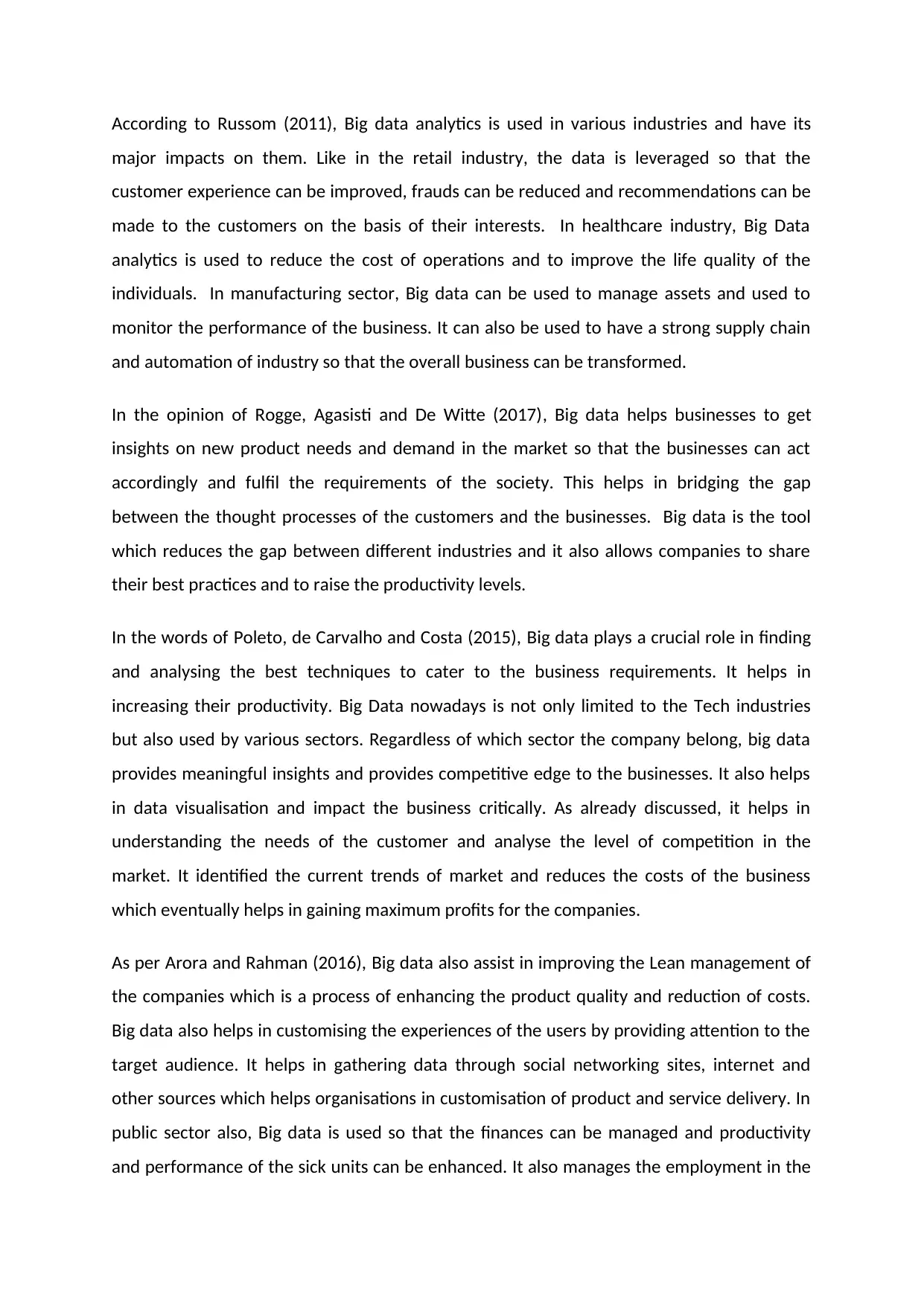
According to Russom (2011), Big data analytics is used in various industries and have its
major impacts on them. Like in the retail industry, the data is leveraged so that the
customer experience can be improved, frauds can be reduced and recommendations can be
made to the customers on the basis of their interests. In healthcare industry, Big Data
analytics is used to reduce the cost of operations and to improve the life quality of the
individuals. In manufacturing sector, Big data can be used to manage assets and used to
monitor the performance of the business. It can also be used to have a strong supply chain
and automation of industry so that the overall business can be transformed.
In the opinion of Rogge, Agasisti and De Witte (2017), Big data helps businesses to get
insights on new product needs and demand in the market so that the businesses can act
accordingly and fulfil the requirements of the society. This helps in bridging the gap
between the thought processes of the customers and the businesses. Big data is the tool
which reduces the gap between different industries and it also allows companies to share
their best practices and to raise the productivity levels.
In the words of Poleto, de Carvalho and Costa (2015), Big data plays a crucial role in finding
and analysing the best techniques to cater to the business requirements. It helps in
increasing their productivity. Big Data nowadays is not only limited to the Tech industries
but also used by various sectors. Regardless of which sector the company belong, big data
provides meaningful insights and provides competitive edge to the businesses. It also helps
in data visualisation and impact the business critically. As already discussed, it helps in
understanding the needs of the customer and analyse the level of competition in the
market. It identified the current trends of market and reduces the costs of the business
which eventually helps in gaining maximum profits for the companies.
As per Arora and Rahman (2016), Big data also assist in improving the Lean management of
the companies which is a process of enhancing the product quality and reduction of costs.
Big data also helps in customising the experiences of the users by providing attention to the
target audience. It helps in gathering data through social networking sites, internet and
other sources which helps organisations in customisation of product and service delivery. In
public sector also, Big data is used so that the finances can be managed and productivity
and performance of the sick units can be enhanced. It also manages the employment in the
major impacts on them. Like in the retail industry, the data is leveraged so that the
customer experience can be improved, frauds can be reduced and recommendations can be
made to the customers on the basis of their interests. In healthcare industry, Big Data
analytics is used to reduce the cost of operations and to improve the life quality of the
individuals. In manufacturing sector, Big data can be used to manage assets and used to
monitor the performance of the business. It can also be used to have a strong supply chain
and automation of industry so that the overall business can be transformed.
In the opinion of Rogge, Agasisti and De Witte (2017), Big data helps businesses to get
insights on new product needs and demand in the market so that the businesses can act
accordingly and fulfil the requirements of the society. This helps in bridging the gap
between the thought processes of the customers and the businesses. Big data is the tool
which reduces the gap between different industries and it also allows companies to share
their best practices and to raise the productivity levels.
In the words of Poleto, de Carvalho and Costa (2015), Big data plays a crucial role in finding
and analysing the best techniques to cater to the business requirements. It helps in
increasing their productivity. Big Data nowadays is not only limited to the Tech industries
but also used by various sectors. Regardless of which sector the company belong, big data
provides meaningful insights and provides competitive edge to the businesses. It also helps
in data visualisation and impact the business critically. As already discussed, it helps in
understanding the needs of the customer and analyse the level of competition in the
market. It identified the current trends of market and reduces the costs of the business
which eventually helps in gaining maximum profits for the companies.
As per Arora and Rahman (2016), Big data also assist in improving the Lean management of
the companies which is a process of enhancing the product quality and reduction of costs.
Big data also helps in customising the experiences of the users by providing attention to the
target audience. It helps in gathering data through social networking sites, internet and
other sources which helps organisations in customisation of product and service delivery. In
public sector also, Big data is used so that the finances can be managed and productivity
and performance of the sick units can be enhanced. It also manages the employment in the
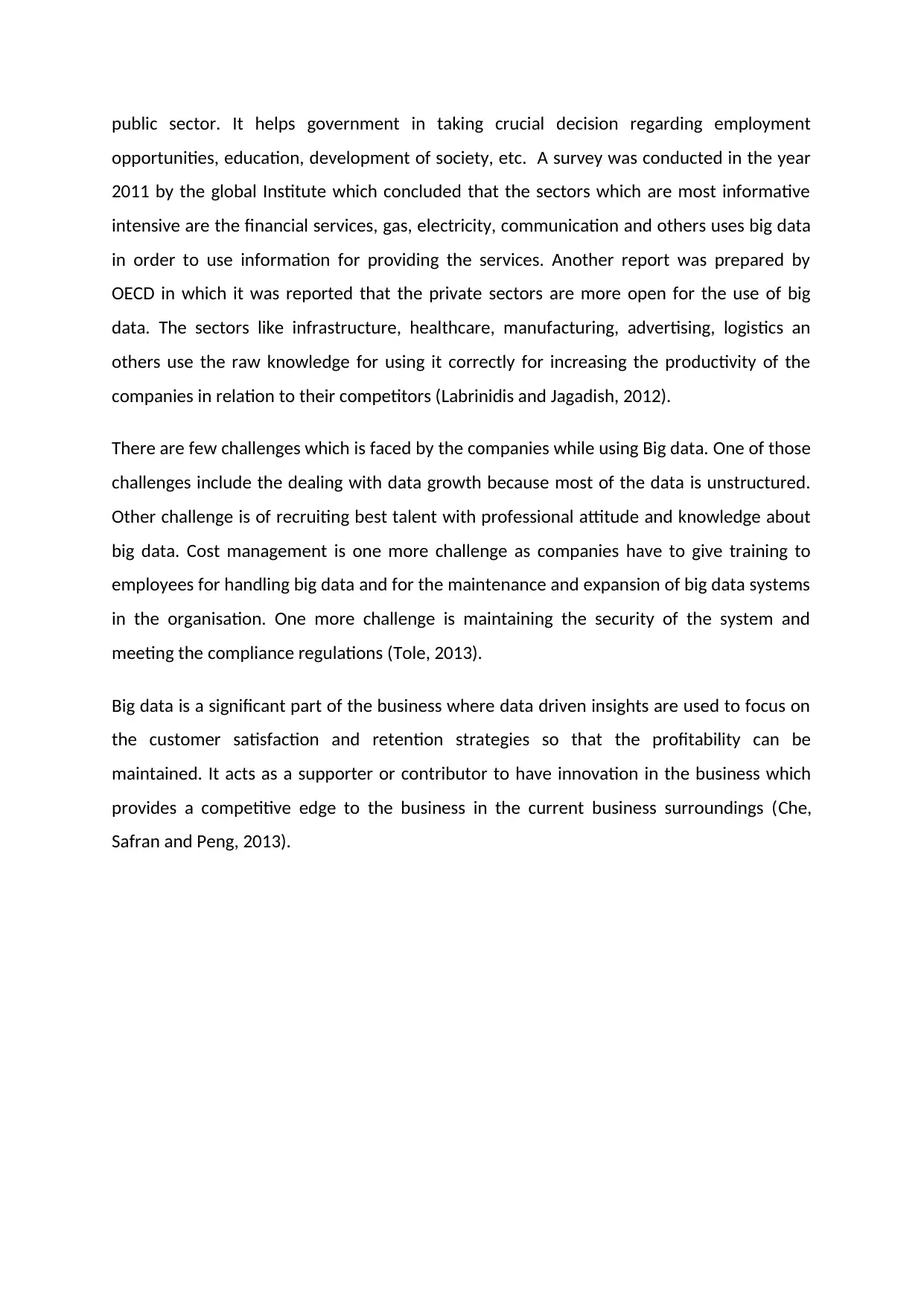
public sector. It helps government in taking crucial decision regarding employment
opportunities, education, development of society, etc. A survey was conducted in the year
2011 by the global Institute which concluded that the sectors which are most informative
intensive are the financial services, gas, electricity, communication and others uses big data
in order to use information for providing the services. Another report was prepared by
OECD in which it was reported that the private sectors are more open for the use of big
data. The sectors like infrastructure, healthcare, manufacturing, advertising, logistics an
others use the raw knowledge for using it correctly for increasing the productivity of the
companies in relation to their competitors (Labrinidis and Jagadish, 2012).
There are few challenges which is faced by the companies while using Big data. One of those
challenges include the dealing with data growth because most of the data is unstructured.
Other challenge is of recruiting best talent with professional attitude and knowledge about
big data. Cost management is one more challenge as companies have to give training to
employees for handling big data and for the maintenance and expansion of big data systems
in the organisation. One more challenge is maintaining the security of the system and
meeting the compliance regulations (Tole, 2013).
Big data is a significant part of the business where data driven insights are used to focus on
the customer satisfaction and retention strategies so that the profitability can be
maintained. It acts as a supporter or contributor to have innovation in the business which
provides a competitive edge to the business in the current business surroundings (Che,
Safran and Peng, 2013).
opportunities, education, development of society, etc. A survey was conducted in the year
2011 by the global Institute which concluded that the sectors which are most informative
intensive are the financial services, gas, electricity, communication and others uses big data
in order to use information for providing the services. Another report was prepared by
OECD in which it was reported that the private sectors are more open for the use of big
data. The sectors like infrastructure, healthcare, manufacturing, advertising, logistics an
others use the raw knowledge for using it correctly for increasing the productivity of the
companies in relation to their competitors (Labrinidis and Jagadish, 2012).
There are few challenges which is faced by the companies while using Big data. One of those
challenges include the dealing with data growth because most of the data is unstructured.
Other challenge is of recruiting best talent with professional attitude and knowledge about
big data. Cost management is one more challenge as companies have to give training to
employees for handling big data and for the maintenance and expansion of big data systems
in the organisation. One more challenge is maintaining the security of the system and
meeting the compliance regulations (Tole, 2013).
Big data is a significant part of the business where data driven insights are used to focus on
the customer satisfaction and retention strategies so that the profitability can be
maintained. It acts as a supporter or contributor to have innovation in the business which
provides a competitive edge to the business in the current business surroundings (Che,
Safran and Peng, 2013).
⊘ This is a preview!⊘
Do you want full access?
Subscribe today to unlock all pages.

Trusted by 1+ million students worldwide
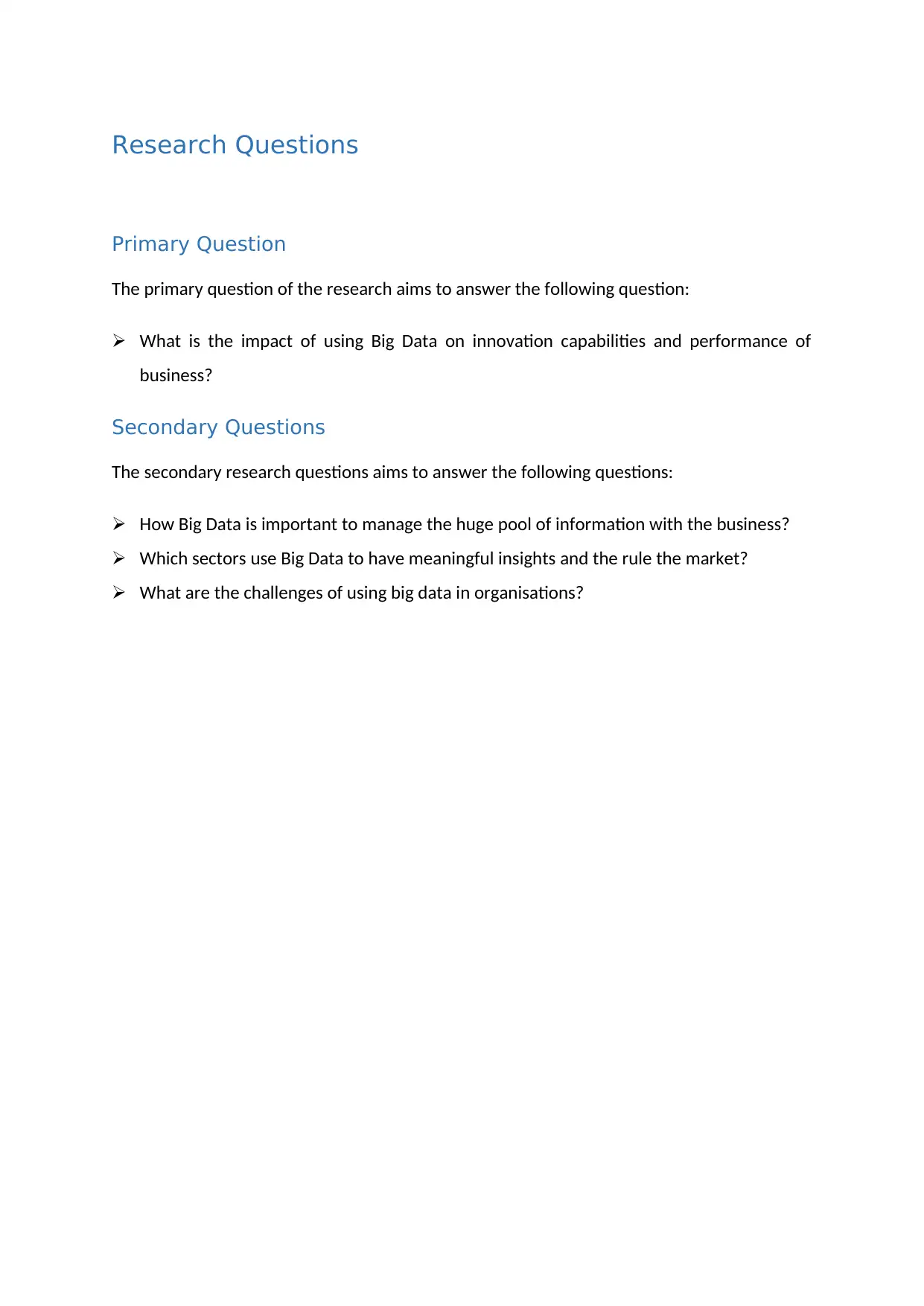
Research Questions
Primary Question
The primary question of the research aims to answer the following question:
What is the impact of using Big Data on innovation capabilities and performance of
business?
Secondary Questions
The secondary research questions aims to answer the following questions:
How Big Data is important to manage the huge pool of information with the business?
Which sectors use Big Data to have meaningful insights and the rule the market?
What are the challenges of using big data in organisations?
Primary Question
The primary question of the research aims to answer the following question:
What is the impact of using Big Data on innovation capabilities and performance of
business?
Secondary Questions
The secondary research questions aims to answer the following questions:
How Big Data is important to manage the huge pool of information with the business?
Which sectors use Big Data to have meaningful insights and the rule the market?
What are the challenges of using big data in organisations?
Paraphrase This Document
Need a fresh take? Get an instant paraphrase of this document with our AI Paraphraser
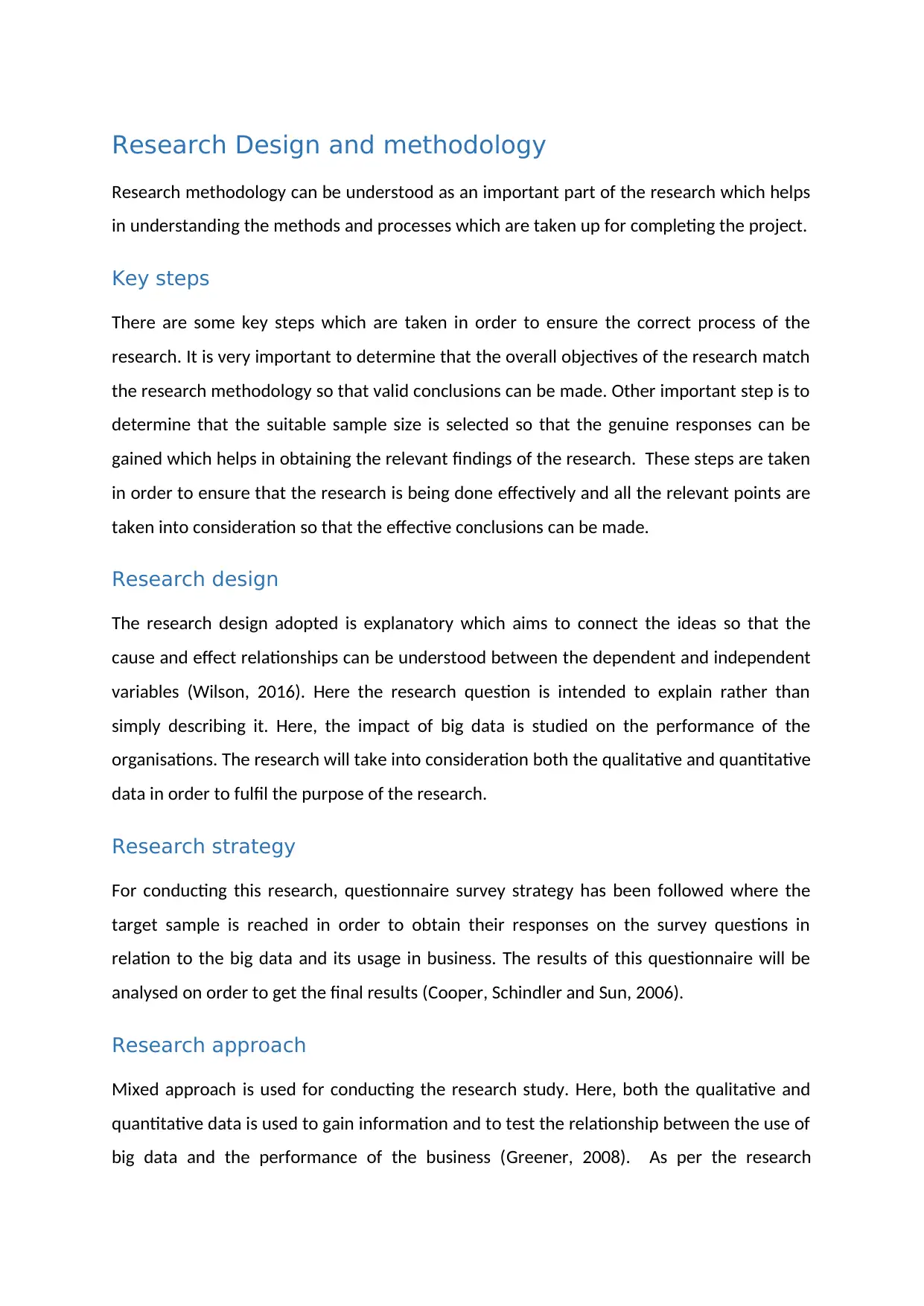
Research Design and methodology
Research methodology can be understood as an important part of the research which helps
in understanding the methods and processes which are taken up for completing the project.
Key steps
There are some key steps which are taken in order to ensure the correct process of the
research. It is very important to determine that the overall objectives of the research match
the research methodology so that valid conclusions can be made. Other important step is to
determine that the suitable sample size is selected so that the genuine responses can be
gained which helps in obtaining the relevant findings of the research. These steps are taken
in order to ensure that the research is being done effectively and all the relevant points are
taken into consideration so that the effective conclusions can be made.
Research design
The research design adopted is explanatory which aims to connect the ideas so that the
cause and effect relationships can be understood between the dependent and independent
variables (Wilson, 2016). Here the research question is intended to explain rather than
simply describing it. Here, the impact of big data is studied on the performance of the
organisations. The research will take into consideration both the qualitative and quantitative
data in order to fulfil the purpose of the research.
Research strategy
For conducting this research, questionnaire survey strategy has been followed where the
target sample is reached in order to obtain their responses on the survey questions in
relation to the big data and its usage in business. The results of this questionnaire will be
analysed on order to get the final results (Cooper, Schindler and Sun, 2006).
Research approach
Mixed approach is used for conducting the research study. Here, both the qualitative and
quantitative data is used to gain information and to test the relationship between the use of
big data and the performance of the business (Greener, 2008). As per the research
Research methodology can be understood as an important part of the research which helps
in understanding the methods and processes which are taken up for completing the project.
Key steps
There are some key steps which are taken in order to ensure the correct process of the
research. It is very important to determine that the overall objectives of the research match
the research methodology so that valid conclusions can be made. Other important step is to
determine that the suitable sample size is selected so that the genuine responses can be
gained which helps in obtaining the relevant findings of the research. These steps are taken
in order to ensure that the research is being done effectively and all the relevant points are
taken into consideration so that the effective conclusions can be made.
Research design
The research design adopted is explanatory which aims to connect the ideas so that the
cause and effect relationships can be understood between the dependent and independent
variables (Wilson, 2016). Here the research question is intended to explain rather than
simply describing it. Here, the impact of big data is studied on the performance of the
organisations. The research will take into consideration both the qualitative and quantitative
data in order to fulfil the purpose of the research.
Research strategy
For conducting this research, questionnaire survey strategy has been followed where the
target sample is reached in order to obtain their responses on the survey questions in
relation to the big data and its usage in business. The results of this questionnaire will be
analysed on order to get the final results (Cooper, Schindler and Sun, 2006).
Research approach
Mixed approach is used for conducting the research study. Here, both the qualitative and
quantitative data is used to gain information and to test the relationship between the use of
big data and the performance of the business (Greener, 2008). As per the research
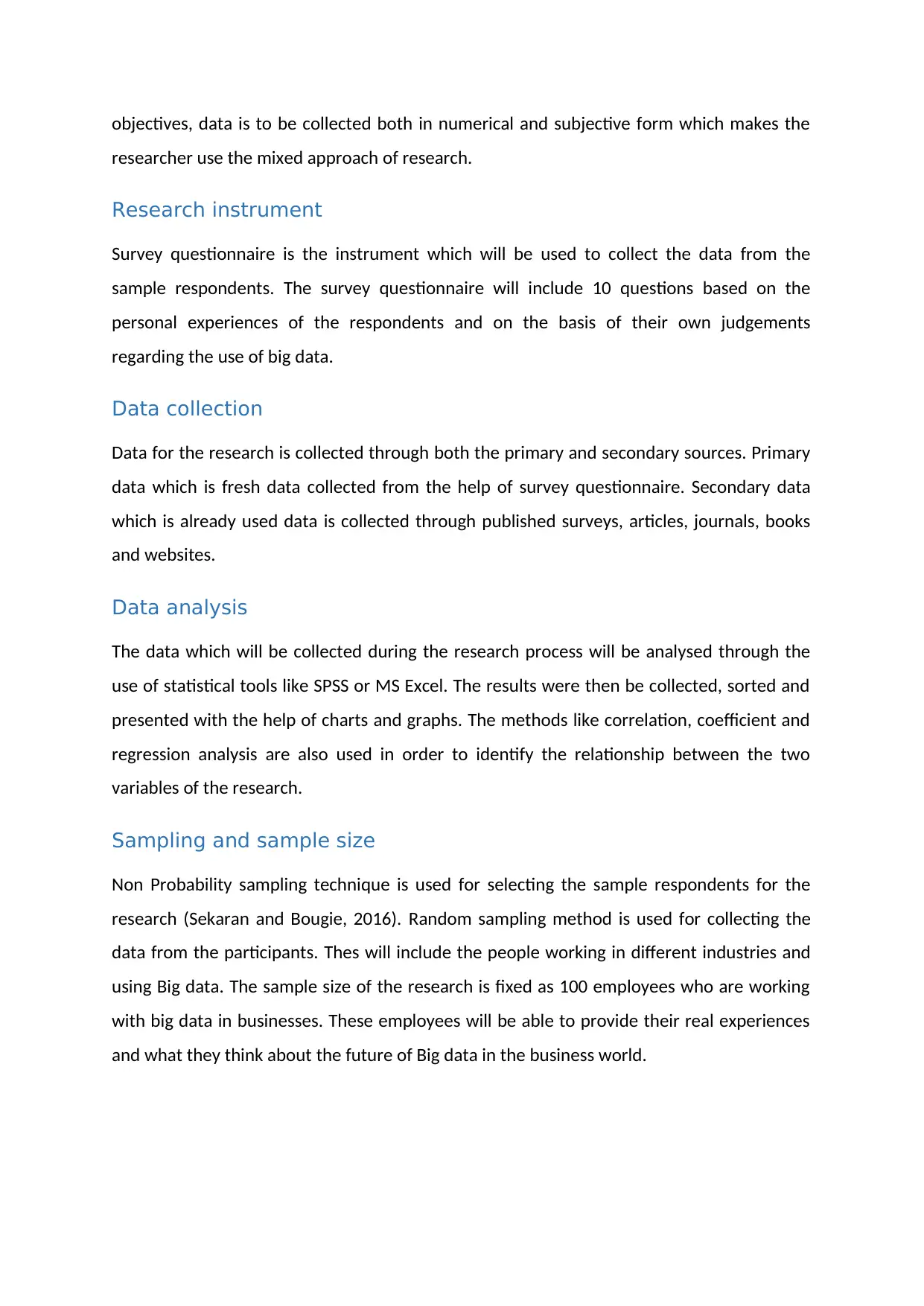
objectives, data is to be collected both in numerical and subjective form which makes the
researcher use the mixed approach of research.
Research instrument
Survey questionnaire is the instrument which will be used to collect the data from the
sample respondents. The survey questionnaire will include 10 questions based on the
personal experiences of the respondents and on the basis of their own judgements
regarding the use of big data.
Data collection
Data for the research is collected through both the primary and secondary sources. Primary
data which is fresh data collected from the help of survey questionnaire. Secondary data
which is already used data is collected through published surveys, articles, journals, books
and websites.
Data analysis
The data which will be collected during the research process will be analysed through the
use of statistical tools like SPSS or MS Excel. The results were then be collected, sorted and
presented with the help of charts and graphs. The methods like correlation, coefficient and
regression analysis are also used in order to identify the relationship between the two
variables of the research.
Sampling and sample size
Non Probability sampling technique is used for selecting the sample respondents for the
research (Sekaran and Bougie, 2016). Random sampling method is used for collecting the
data from the participants. Thes will include the people working in different industries and
using Big data. The sample size of the research is fixed as 100 employees who are working
with big data in businesses. These employees will be able to provide their real experiences
and what they think about the future of Big data in the business world.
researcher use the mixed approach of research.
Research instrument
Survey questionnaire is the instrument which will be used to collect the data from the
sample respondents. The survey questionnaire will include 10 questions based on the
personal experiences of the respondents and on the basis of their own judgements
regarding the use of big data.
Data collection
Data for the research is collected through both the primary and secondary sources. Primary
data which is fresh data collected from the help of survey questionnaire. Secondary data
which is already used data is collected through published surveys, articles, journals, books
and websites.
Data analysis
The data which will be collected during the research process will be analysed through the
use of statistical tools like SPSS or MS Excel. The results were then be collected, sorted and
presented with the help of charts and graphs. The methods like correlation, coefficient and
regression analysis are also used in order to identify the relationship between the two
variables of the research.
Sampling and sample size
Non Probability sampling technique is used for selecting the sample respondents for the
research (Sekaran and Bougie, 2016). Random sampling method is used for collecting the
data from the participants. Thes will include the people working in different industries and
using Big data. The sample size of the research is fixed as 100 employees who are working
with big data in businesses. These employees will be able to provide their real experiences
and what they think about the future of Big data in the business world.
⊘ This is a preview!⊘
Do you want full access?
Subscribe today to unlock all pages.

Trusted by 1+ million students worldwide
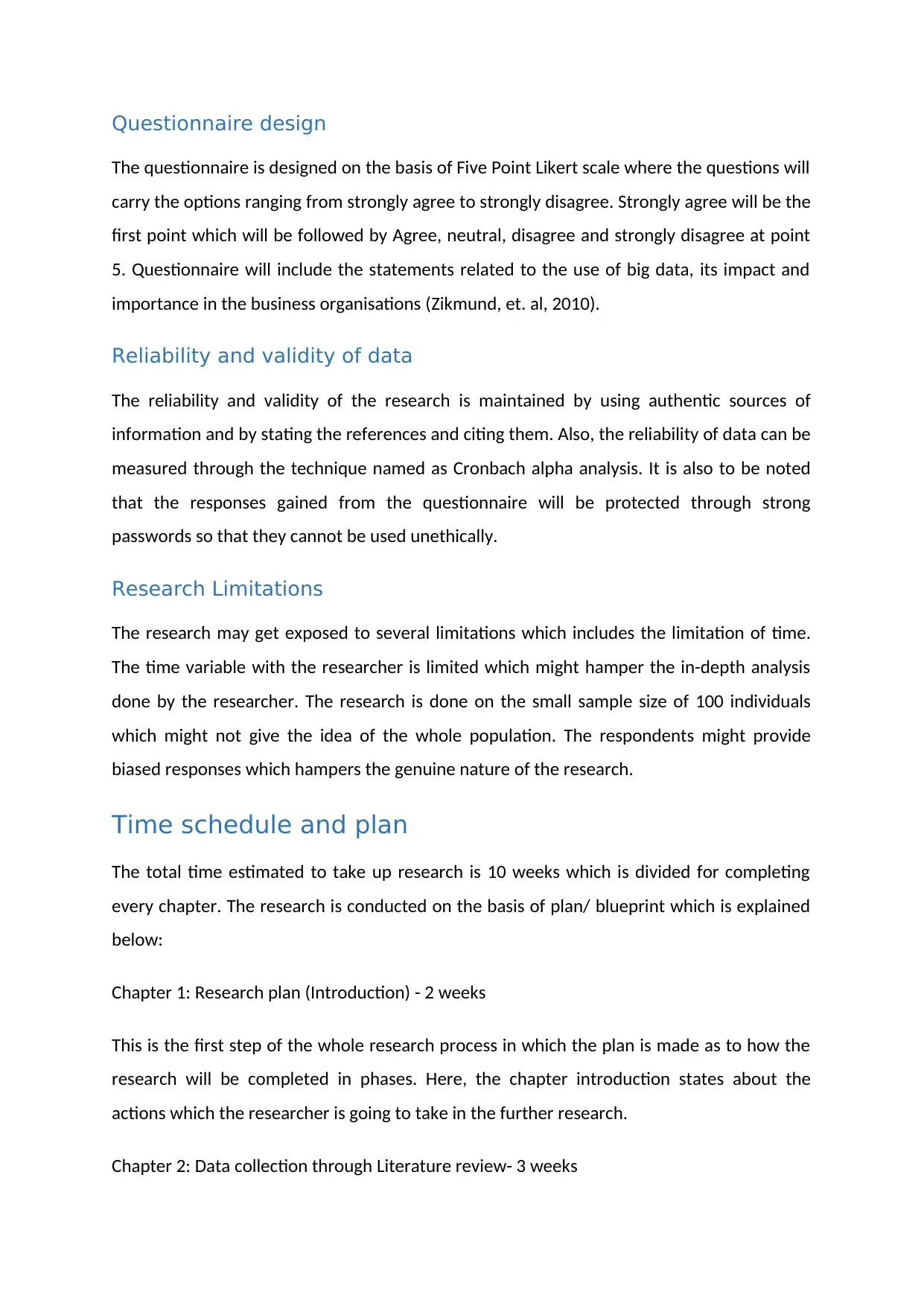
Questionnaire design
The questionnaire is designed on the basis of Five Point Likert scale where the questions will
carry the options ranging from strongly agree to strongly disagree. Strongly agree will be the
first point which will be followed by Agree, neutral, disagree and strongly disagree at point
5. Questionnaire will include the statements related to the use of big data, its impact and
importance in the business organisations (Zikmund, et. al, 2010).
Reliability and validity of data
The reliability and validity of the research is maintained by using authentic sources of
information and by stating the references and citing them. Also, the reliability of data can be
measured through the technique named as Cronbach alpha analysis. It is also to be noted
that the responses gained from the questionnaire will be protected through strong
passwords so that they cannot be used unethically.
Research Limitations
The research may get exposed to several limitations which includes the limitation of time.
The time variable with the researcher is limited which might hamper the in-depth analysis
done by the researcher. The research is done on the small sample size of 100 individuals
which might not give the idea of the whole population. The respondents might provide
biased responses which hampers the genuine nature of the research.
Time schedule and plan
The total time estimated to take up research is 10 weeks which is divided for completing
every chapter. The research is conducted on the basis of plan/ blueprint which is explained
below:
Chapter 1: Research plan (Introduction) - 2 weeks
This is the first step of the whole research process in which the plan is made as to how the
research will be completed in phases. Here, the chapter introduction states about the
actions which the researcher is going to take in the further research.
Chapter 2: Data collection through Literature review- 3 weeks
The questionnaire is designed on the basis of Five Point Likert scale where the questions will
carry the options ranging from strongly agree to strongly disagree. Strongly agree will be the
first point which will be followed by Agree, neutral, disagree and strongly disagree at point
5. Questionnaire will include the statements related to the use of big data, its impact and
importance in the business organisations (Zikmund, et. al, 2010).
Reliability and validity of data
The reliability and validity of the research is maintained by using authentic sources of
information and by stating the references and citing them. Also, the reliability of data can be
measured through the technique named as Cronbach alpha analysis. It is also to be noted
that the responses gained from the questionnaire will be protected through strong
passwords so that they cannot be used unethically.
Research Limitations
The research may get exposed to several limitations which includes the limitation of time.
The time variable with the researcher is limited which might hamper the in-depth analysis
done by the researcher. The research is done on the small sample size of 100 individuals
which might not give the idea of the whole population. The respondents might provide
biased responses which hampers the genuine nature of the research.
Time schedule and plan
The total time estimated to take up research is 10 weeks which is divided for completing
every chapter. The research is conducted on the basis of plan/ blueprint which is explained
below:
Chapter 1: Research plan (Introduction) - 2 weeks
This is the first step of the whole research process in which the plan is made as to how the
research will be completed in phases. Here, the chapter introduction states about the
actions which the researcher is going to take in the further research.
Chapter 2: Data collection through Literature review- 3 weeks
Paraphrase This Document
Need a fresh take? Get an instant paraphrase of this document with our AI Paraphraser
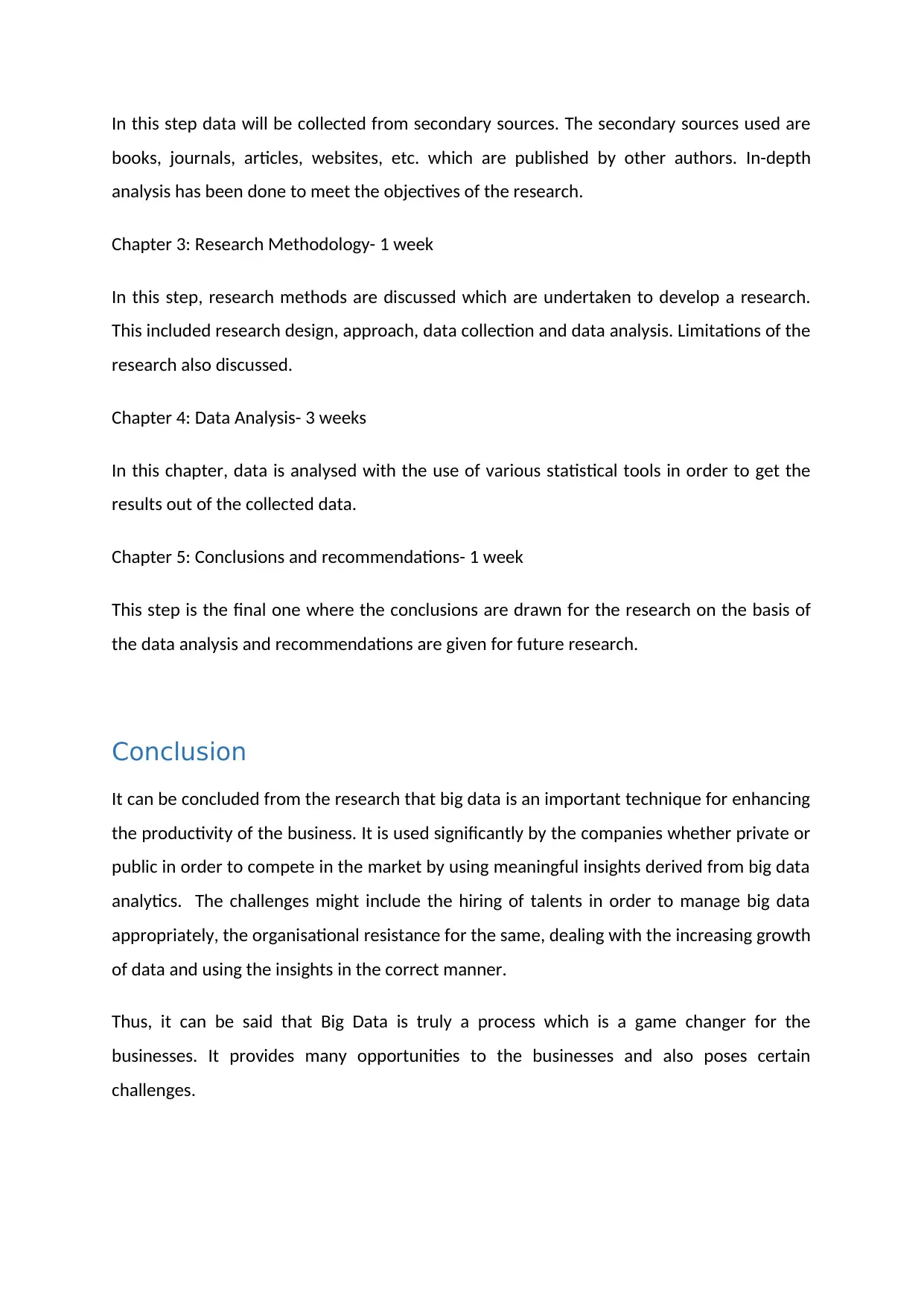
In this step data will be collected from secondary sources. The secondary sources used are
books, journals, articles, websites, etc. which are published by other authors. In-depth
analysis has been done to meet the objectives of the research.
Chapter 3: Research Methodology- 1 week
In this step, research methods are discussed which are undertaken to develop a research.
This included research design, approach, data collection and data analysis. Limitations of the
research also discussed.
Chapter 4: Data Analysis- 3 weeks
In this chapter, data is analysed with the use of various statistical tools in order to get the
results out of the collected data.
Chapter 5: Conclusions and recommendations- 1 week
This step is the final one where the conclusions are drawn for the research on the basis of
the data analysis and recommendations are given for future research.
Conclusion
It can be concluded from the research that big data is an important technique for enhancing
the productivity of the business. It is used significantly by the companies whether private or
public in order to compete in the market by using meaningful insights derived from big data
analytics. The challenges might include the hiring of talents in order to manage big data
appropriately, the organisational resistance for the same, dealing with the increasing growth
of data and using the insights in the correct manner.
Thus, it can be said that Big Data is truly a process which is a game changer for the
businesses. It provides many opportunities to the businesses and also poses certain
challenges.
books, journals, articles, websites, etc. which are published by other authors. In-depth
analysis has been done to meet the objectives of the research.
Chapter 3: Research Methodology- 1 week
In this step, research methods are discussed which are undertaken to develop a research.
This included research design, approach, data collection and data analysis. Limitations of the
research also discussed.
Chapter 4: Data Analysis- 3 weeks
In this chapter, data is analysed with the use of various statistical tools in order to get the
results out of the collected data.
Chapter 5: Conclusions and recommendations- 1 week
This step is the final one where the conclusions are drawn for the research on the basis of
the data analysis and recommendations are given for future research.
Conclusion
It can be concluded from the research that big data is an important technique for enhancing
the productivity of the business. It is used significantly by the companies whether private or
public in order to compete in the market by using meaningful insights derived from big data
analytics. The challenges might include the hiring of talents in order to manage big data
appropriately, the organisational resistance for the same, dealing with the increasing growth
of data and using the insights in the correct manner.
Thus, it can be said that Big Data is truly a process which is a game changer for the
businesses. It provides many opportunities to the businesses and also poses certain
challenges.
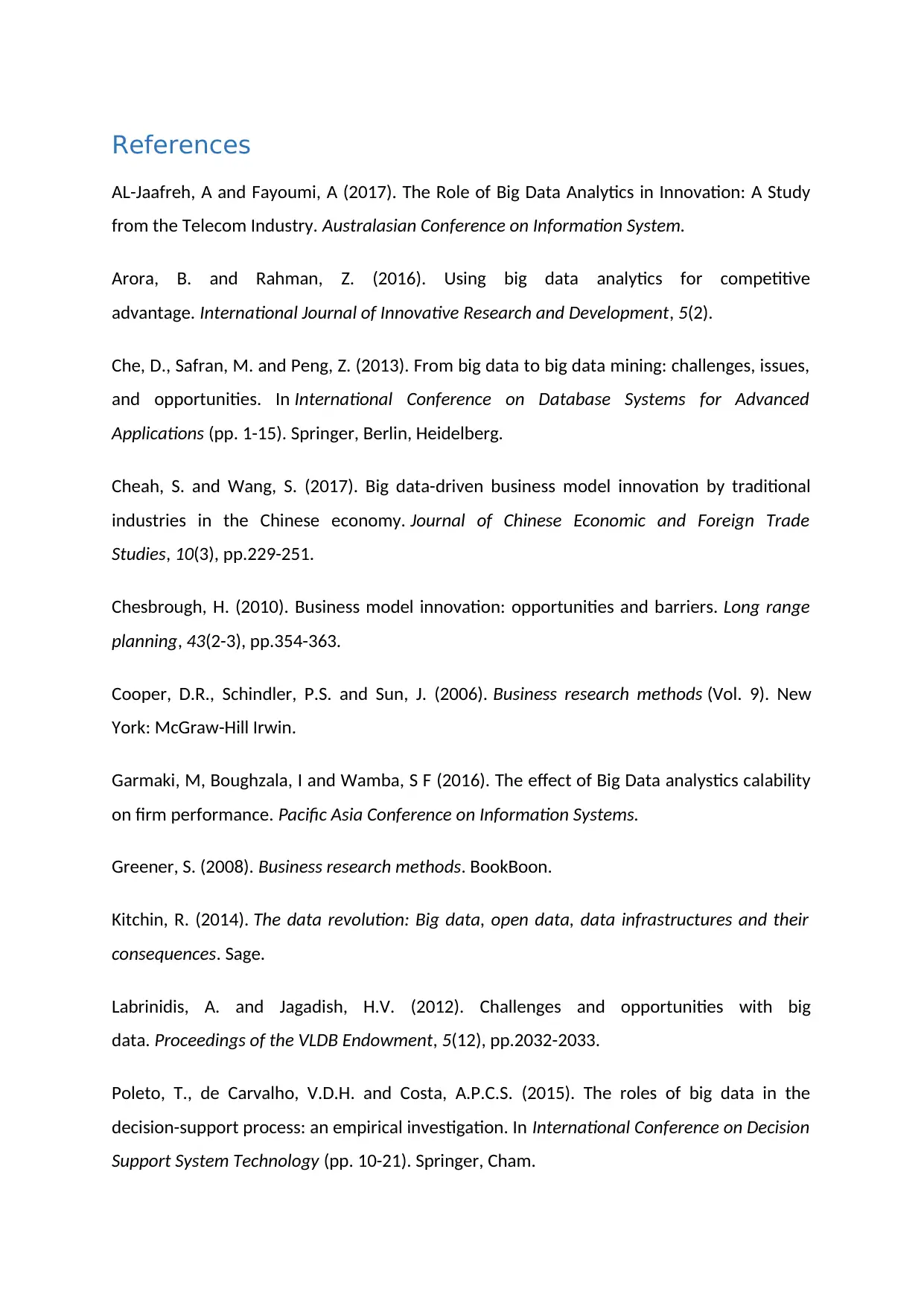
References
AL-Jaafreh, A and Fayoumi, A (2017). The Role of Big Data Analytics in Innovation: A Study
from the Telecom Industry. Australasian Conference on Information System.
Arora, B. and Rahman, Z. (2016). Using big data analytics for competitive
advantage. International Journal of Innovative Research and Development, 5(2).
Che, D., Safran, M. and Peng, Z. (2013). From big data to big data mining: challenges, issues,
and opportunities. In International Conference on Database Systems for Advanced
Applications (pp. 1-15). Springer, Berlin, Heidelberg.
Cheah, S. and Wang, S. (2017). Big data-driven business model innovation by traditional
industries in the Chinese economy. Journal of Chinese Economic and Foreign Trade
Studies, 10(3), pp.229-251.
Chesbrough, H. (2010). Business model innovation: opportunities and barriers. Long range
planning, 43(2-3), pp.354-363.
Cooper, D.R., Schindler, P.S. and Sun, J. (2006). Business research methods (Vol. 9). New
York: McGraw-Hill Irwin.
Garmaki, M, Boughzala, I and Wamba, S F (2016). The effect of Big Data analystics calability
on firm performance. Pacific Asia Conference on Information Systems.
Greener, S. (2008). Business research methods. BookBoon.
Kitchin, R. (2014). The data revolution: Big data, open data, data infrastructures and their
consequences. Sage.
Labrinidis, A. and Jagadish, H.V. (2012). Challenges and opportunities with big
data. Proceedings of the VLDB Endowment, 5(12), pp.2032-2033.
Poleto, T., de Carvalho, V.D.H. and Costa, A.P.C.S. (2015). The roles of big data in the
decision-support process: an empirical investigation. In International Conference on Decision
Support System Technology (pp. 10-21). Springer, Cham.
AL-Jaafreh, A and Fayoumi, A (2017). The Role of Big Data Analytics in Innovation: A Study
from the Telecom Industry. Australasian Conference on Information System.
Arora, B. and Rahman, Z. (2016). Using big data analytics for competitive
advantage. International Journal of Innovative Research and Development, 5(2).
Che, D., Safran, M. and Peng, Z. (2013). From big data to big data mining: challenges, issues,
and opportunities. In International Conference on Database Systems for Advanced
Applications (pp. 1-15). Springer, Berlin, Heidelberg.
Cheah, S. and Wang, S. (2017). Big data-driven business model innovation by traditional
industries in the Chinese economy. Journal of Chinese Economic and Foreign Trade
Studies, 10(3), pp.229-251.
Chesbrough, H. (2010). Business model innovation: opportunities and barriers. Long range
planning, 43(2-3), pp.354-363.
Cooper, D.R., Schindler, P.S. and Sun, J. (2006). Business research methods (Vol. 9). New
York: McGraw-Hill Irwin.
Garmaki, M, Boughzala, I and Wamba, S F (2016). The effect of Big Data analystics calability
on firm performance. Pacific Asia Conference on Information Systems.
Greener, S. (2008). Business research methods. BookBoon.
Kitchin, R. (2014). The data revolution: Big data, open data, data infrastructures and their
consequences. Sage.
Labrinidis, A. and Jagadish, H.V. (2012). Challenges and opportunities with big
data. Proceedings of the VLDB Endowment, 5(12), pp.2032-2033.
Poleto, T., de Carvalho, V.D.H. and Costa, A.P.C.S. (2015). The roles of big data in the
decision-support process: an empirical investigation. In International Conference on Decision
Support System Technology (pp. 10-21). Springer, Cham.
⊘ This is a preview!⊘
Do you want full access?
Subscribe today to unlock all pages.

Trusted by 1+ million students worldwide
1 out of 14
Related Documents
Your All-in-One AI-Powered Toolkit for Academic Success.
+13062052269
info@desklib.com
Available 24*7 on WhatsApp / Email
![[object Object]](/_next/static/media/star-bottom.7253800d.svg)
Unlock your academic potential
Copyright © 2020–2025 A2Z Services. All Rights Reserved. Developed and managed by ZUCOL.





